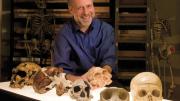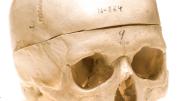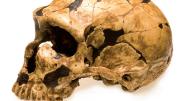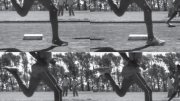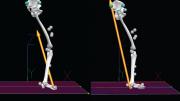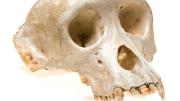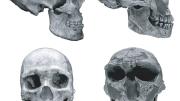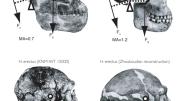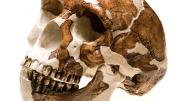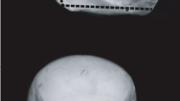Beneath shelves of books on the biology of bone, a collection of skulls and running shoes lies in a jumble on a countertop. The skulls come in a range of sizes and shapes, from the tiny and sharp-toothed, with large orbits for the eyes, to the hefty and humanoid. The shoes are likewise varied, from brightly colored Nikes, to fluorescent ASICS, to slipper-like Vibram FiveFingers™ with separated toes—like a glove—intended to mimic barefoot running. These collections neatly bracket the research interests of Daniel Lieberman, human evolutionary biologist: a head-to-toe interest in the human body, its morphology (the science of an organism’s form, including the study of specific structural features), its development, and its evolution.
“I do seem to end up working on the two ends of the body, and not so much in between,” he muses. “I never thought that would happen in my career. It’s bizarre.”
But the apparent dichotomy is bizarre only in the abstract, because Lieberman’s interest in feet—and human endurance running—began with his interest in heads. The two subjects are deeply linked. The theory that humans evolved to become endurance runners so talented that a team of barefoot hunters on a hot African savanna could actually run a large antelope to ground is based in part on skeletal evidence from the head—a subject about which Lieberman has just published a weighty book, 15 years in the making.
“Many of the things we value most—our big brains, speech, much of our sensory biology—are in the head,” Lieberman explains. “It is the size of a soccer ball, and think what it does”: seeing, hearing, tasting, smelling, balancing, thinking, speaking, chewing, swallowing, breathing, and regulating body temperature. Lieberman’s book considers in detail how each of these functions works from a biomechanical perspective, and then theorizes how each evolved, simultaneously with the others, as part of an integrated whole.
“The head presents an interesting evolutionary paradox,” explains Lieberman, chair of the new department of human evolutionary biology, “because on the one hand it is so complicated that if anything goes wrong, the organism dies. On the other hand, it is where natural selection can and has acted powerfully to make us what we are.” Everything is closely connected. For example, the roof of the orbits is the floor of the brain—if one changes, they both do.
“How is it,” he asks, “that something so complicated and so vital can also be so evolvable?” One explanation involves modularity and integration. Not only do heads contain many modules (instructions for building an eye to see, for example, or an ear to listen), but each module is itself “intensely integrated in terms of development, structure, and function….Changes to the size, the shape, or the relative timing of development of each of the head’s many modules offer a variety of opportunities for change.” Studying the head’s modules, Lieberman writes, may help us understand why “the human head has changed substantially since our lineage diverged from the chimpanzee’s lineage.” It also provides an opportunity for “exploring how nature tinkers with development in ways that affect function and permit the evolution of complex structures.”
Though written so anyone can read it, The Evolution of the Human Head (Harvard University Press) “is not meant to be a bestseller,” he avers. Nevertheless, Lieberman takes up all sorts of interesting questions, such as why humans have big noses (there is a link to running), chins (nobody really knows), small faces that are tucked under the brain, and teeth that are suitable only for eating processed food. In short: Why does the head look the way it does?
To probe such mysteries, Lieberman uses a variety of techniques. (The book draws on the expertise of many scholars as well as his own work.) Experimental biomechanics is one. About nine years ago, while contemplating why human faces have become smaller in the brief span of recorded history—too short a time for evolution to explain—Lieberman wondered whether the modern diet of soft food might be a contributing factor. As bones grow, their size and shape respond to biomechanical stresses, so he decided to study the effects of chewing hard versus soft food on the growth and development of the skull in various animal species. In one experiment, he fed soft food to one group of pigs, hard food to another. The stresses of chewing made the upper and lower jaws of the pigs eating hard food grow larger. The study suggested that there is a link between smaller jaws and regularly chewing very high-quality soft food. And humans, he points out, have never had greater access to high-energy processed food than they do now. “I think many people today never have to actually chew anything all day long,” he says. “You can see the effects of that shift in our heads now in terms of molar impactions”—small faces and jaws leave too little room for teeth.
Recently he has been probing that shift by feeding humans raw versus cooked goat—a tough, game-like meat—and measuring the activity of their chewing muscles using electrodes. “We want to know how humans managed to eat meat before cooking was invented,” he says, “and we want to know how cooking and tenderizing changed how much we use our chewing muscles.”
Another recent biomechanical experiment, on the effects of shoes on skeletal growth, employed sheep. Putting shoes on sheep “sounds kind of crazy,” Lieberman admits, “but people wearing high heels change the angles of their joints. We wanted to see how that would affect how the joints develop,” so his team put plastic booties on the sheep and fitted them with balsawood lifts to simulate high heels.
“We soon discovered that the sheep were much better off wearing socks with their shoes.” A smile plays across Lieberman’s face at the thought. “A wonderful postdoc of mine with a degree in veterinary science developed this method where the sheep would lie down in his lap and then he would put the socks on them and then the shoes.” The sheep then spent the day wearing the shoes on their front feet and running on a treadmill. “We tried to get them to wear them at night, but they always kicked them off. In the morning you would come in and there would be shoes all over the place.”
After a few months, the researchers were able to measure the growth rate of the shod sheep using computed axial tomography (CT) scans. “We will be able to extrapolate the effect of wearing shoes from that,” he says, though analysis of the data is not yet complete.
Back in his office in the Peabody Museum, Lieberman uses comparative morphology and modeling to complement the biomechanical research. Computerized scans of skulls and other bones let him study their shapes in three dimensions, and easily compare the volume or size of a structure within an ape’s skull, for example, to that of a modern human (in which the temporal lobe is about 25 percent larger, relatively) in order to ask questions about human evolution. CT scans of fetal human skulls at progressively later stages of growth let him pose developmental questions focusing on trade-offs in the expansion of one part of the skull as opposed to another.
In a nearby laboratory, a treadmill that measures the force of impact when a runner’s foot strikes the ground allows Lieberman to test models of how bones work and develop. “We might test a model that asks, ‘How is a bone like a beam?’” he explains. “We can then measure the strains that apply to that beam and see how they affect the growth of the bone.” When the treadmill data are combined with imagery from high-speed infrared video cameras that can calculate their own precise location in space, and that track infrared fluorescent markers attached at a runner’s joints, the apparatus allows Lieberman to calculate the forces on joints all the way up to the hips. He can do the same with a chewing jaw. “We can tie forces in biomechanics and function to development and anatomy. And ultimately, to evolution,” he explains, because skeletons have changed. “We can’t measure how an australopithecine or Homo habilis or Homo erectus behaved, but the same principles of biomechanics and Newtonian physics apply to them and us, so we can estimate the bite force of Homo erectus by testing a model in Homo sapiens.” A second treadmill fitted with a full-face respirator for measuring oxygen use allows Lieberman to measure running economy. “It turns out barefoot runners are about 5 percent more economical than shod runners, even after you account for the weight of the shoe,” he reports. “We are trying to figure out why.”
Lieberman’s interest in running began with his research on the head in conjunction with Dennis Bramble from the University of Utah. Alone among apes, humans have a special ligament at the nape of the neck, attached at the back of the skull, that apparently helps the head to remain stable during running. Humans also have external noses combined with short inner nasal cavities that create turbulence in several ways during breathing, adaptations that may increase the ability to humidify incoming air, or dehumidify exhaled air, in arid climates. “We can also see in the fossil record when human heads develop larger organs of balance [the semicircular canals] that are better able to sense the rapid pitching motions caused by running,” Lieberman says. This was about two million years ago, when humans began eating meat. These changes in the ears, neck, and nose, along with more balanced heads, may all be features that allowed early human endurance hunters to chase prey until it collapsed from heat stroke.
He devotes a chapter of his new book to the pharynx, of which the nose is the most charismatic part. “It’s just a tube,” he says, “but wow! What a tube. It is so dizzyingly complicated”—the book describes the elaborate interplay of dozens of muscles—“and involved in so much: speech, swallowing, breathing, and thermoregulation. All of those things are incredibly important and yet that one tube has to do all of it. If you study the pharynx just from the perspective of language or thermoregulation you will miss part of the whole story.”
He explains the advantages of this holistic approach by using the evolution of speech as an example. “Close human relatives like Neanderthals probably had a vocal tract that was capable of fairly impressive speech, but probably not as articulate as ours,” he notes. “But you have to put probabilities around that inference, and you do that by thinking about the vocal tract not just in terms of speech, but also in terms of swallowing and respiration and development, and all the other things that a vocal tract must do in order for a person merely to live.” When writing the book, he employed this strategy to engage in a thought experiment, using models of all the life-supporting systems located in the head to limit or constrain the possibilities for the development of speech. Such models allowed him to toy with the evolutionary possibilities—and create a hypothetical australopithecine head that meets all the necessary conditions.
The fact that humans have smaller, more retracted faces than other hominins* is another way of unpacking the notion of interconnectedness in the head. Having a small face affects the pharynx; the amount of turbulence during respiration and thermoregulation; speech (because it shortens the vocal tract); and how we chew (because it makes human jaws more efficient at producing force). “The fun challenge of facial reduction is that it is a chicken-and-egg problem,” says Lieberman. “It is very hard to say that one change preceded another; in the head, everything happens in conjunction with everything else.”
For the most part, Lieberman confines the discussion in his new book to the complex developmental, functional, and evolutionary relationships among different modules in the head. But in the final pages, he allows himself to speculate about the most important drivers of human evolutionary change: energy, climate change, open habitat, and speech. Energy is the most interesting of these, he says, because humans are “bizarre creatures energetically. For example, most big-bodied animals eat low-quality food. We’re big-bodied animals that eat really high-quality food and we make it even higher in quality by processing it and cooking it. A chimpanzee spends half its day eating because it has to chew raw, tough food, while an undergraduate could go all day eating everything through a straw.”
Humans are also unusual in energy expenditure: thrifty in regard to locomotion, extravagant in brain function and reproduction. The Homo sapiens brain draws as much as 15 percent of the blood and 25 percent of the body’s essential energy supply at any moment—“incredibly expensive. The brain has to have that constantly,” Lieberman points out. And no other great ape is as fecund. “A chimpanzee mother has babies every six years. Human hunter-gatherers have them every three years. Now, we can have them every single year.”
Energetic abilities, such as endurance running, are another distinctive human feature: “There are very few animals that will willingly run five to 10 miles, let alone a marathon,” he says. Most humans are good at endurance, but pathetic at speed: “My dog is faster than I am—but my dog could never run a marathon.”
To power these extraordinary capacities, he continues, humans need reservoirs of stored energy for reproduction and endurance. Not surprisingly, therefore, we are a fat species. “Even the thin amongst us—a typical hunter-gatherer has 10 to 15 percent body fat—are fat compared to other primates.
“You simply can’t understand human evolution unless you think about energy,” Lieberman believes. “I think that is something you see in the head in terms of the costs of the tissues: the fact that the brain uses so much energy has ramifications for the whole body. The fact that our teeth are designed for eating processed food signals an energy shift. Our heads don’t even grow properly because of cooking,” he stresses. “The origins of bipedalism, of hunting and gathering, of projectile technology, of cooking, and of reproductive shifts—I think a lot of human evolution was about new ways to get energy and new ways to use energy.” Pausing in his train of thoughts, Lieberman says with a laugh, “You’ve got to have some fun speculating, right?”
